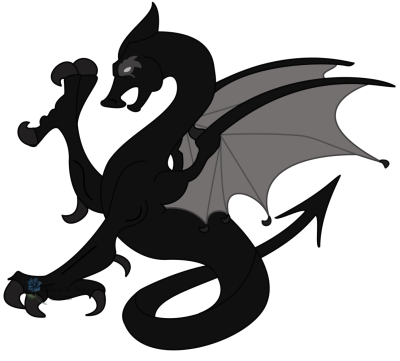Ivenkli
Jump to navigation
Jump to search

- Size: 28-33 hands high at shoulder (112-132 inches/285.6-336.6 cm)
- Special Ability: They have a unique ability to assume any shape they care to. Status among them is partly determined by how long they can hold complex forms.
- Breath Weapon: They have an organ in their chest that allows them to spit a powerful acid which can eat through virtually anything. It is this organ that allows them to consume anything. Blacks are also immune to poison as the acid destroys it before it can take effect.
- Eggs: Eggs are large and splotchy grey in color for this species.
- Hatching Grounds: Ivenkli are nest builders. Dried foliage is their primary nest material, but the have been known to use cloth as well.
- Males and females are easy to distinguish as the males are smaller in size, not growing much beyond 28 hands at the shoulder. They have pale grey wingsails and black talons. Males are also quite timid, so they aren’t seen much outside of the clan’s territory. Females have dark grey wingsails and blood red talons. They are extremely vicious and are well known for their short tempers.
- They have two major population centers in which the Darkriders have built permanent structures: Nightmare Bluff, which is their primary location, and the Shadow Citadel, which is secondary. Despite being their secondary location, Shadow Citadel is the most strategic as it is located on the banks of the River Arcetes. It has been used as a staging area in every major offensive against the Dragonlords and the Sisterhood of Sword and Sorcery.
- Also in their territory lies Twilight Valley. It is the primary source of the Darkriders’ wealth and is a very heavily guarded secret. Slaves sent to this mine are sent into a death sentence as no one leaves again. The slaves mine the area for gems such as beryl, sapphire, diamonds, and the extremely rare star gems.
- They put great importance on birth order. Younger hatchlings will sometimes try to kill older nestmates to improve their status.